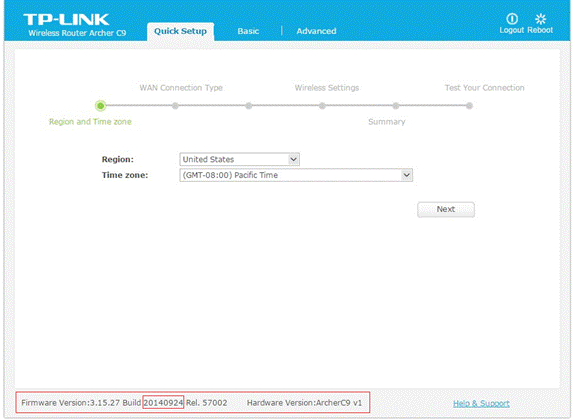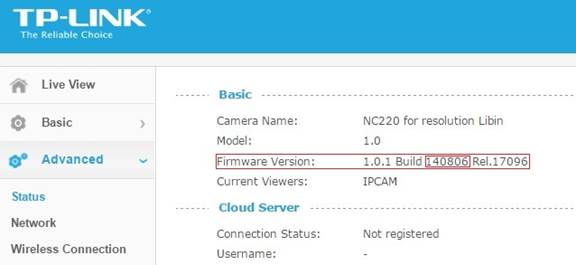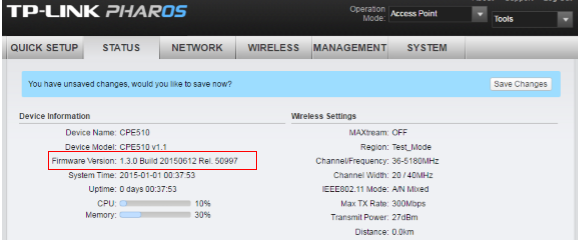How to find the hardware and firmware version of my TP-Link device
TL63-5 , Tapo L930-10 , Archer AX95 , Archer AX96 , Tapo L930 , Tapo C310 , Archer AX90 , Tapo S210 , Tapo L930-5 , Archer AX5400 , Tapo P115M , Tapo T300 , TL13E , Tapo C201 , Tapo C202 , Tapo RVA300 , Tapo S505D , Tapo C200 , Tapo H100 , Tapo L900-20 , Archer AX80 , Archer AX4200 , Tapo RV30C Mop Plus , TL62-5 , Archer AX75 , TC40GW , Archer AX73 , Tapo L925-5 , Tapo C410 , Tapo C320WS , PW15 , Tapo L900 , Archer AX72 , Archer AX68 , Archer AX5300 , Tapo P125M , Tapo C425 , Tapo RVA200 , Tapo S200B , Tapo L920 , Tapo C420 , Tapo H200 , Tapo C510W , Tapo S200D , Archer AXE300 , Archer AX1500 , Archer AX60 , Tapo RV10 Lite , Archer AX73V , Archer AX3000 , Tapo C325WB , Archer AX58 , Archer AX55 , Archer AX53 , Archer AX51 , Tapo L531E , Tapo RV20 Mop Plus , Tapo C310P2 , Archer AX50 , Tapo C51A , Archer AX6000 , Tapo RVA100 , Tapo C400 , Tapo RVA101 , Tapo RVA102 , Tapo L520E , Tapo RVA103 , Tapo C425 + Tapo A200 , TL61-10 , Archer AX1800 , Tapo L920-10 , Tapo C52A , Tapo RV20 Max , Tapo RV30 Plus , Archer AX4400 , Tapo S500 , Tapo P110 , Tapo S505 , Tapo C425 + A200 , Tapo L900-5 , Tapo P115 , Archer AX80V , Tapo C501GW , Archer AXE5400V , Archer AXE200 Omni , Archer AX23 , Tapo P360 , Tapo C400S1 , Archer AX20 , Tapo C400S2 , Tapo RV20 Mop , Archer AX21 , Archer AX3000V , Tapo L530B , Tapo L530E , Tapo P125 , Tapo C500 , Tapo A200 , Tapo C860 , Tapo P105A , Archer AX3200 , Tapo C210P2 , Tapo L535B , Archer AX12 , Archer AX10 , Tapo RV20 , Tapo D230S1 , Tapo L535E , Tapo TC70 , Archer AX17 , Archer AX18 , Archer AX15 , Tapo C530WS , Tapo RV20 Plus , Tapo D130 , Archer AXE95 , Tapo TC65 , Archer AX10000 , Tapo L530EA , Tapo L536E , Tapo RV30 , Tapo P100 , Tapo P105 , Tapo C720 , Tapo E100 , Tapo RV30C Mop , Tapo P110MA , Archer AXE5400 , Archer AX5400 Pro , TC82 KIT , Tapo T110 , Tapo S500D , Tapo RV30C , Tapo L630 , Tapo L510 , Tapo D100 , TCB82 , Tapo D230 , Archer AXE75 , Archer AX1450 , Tapo P135 KIT , Tapo C200P2 , Tapo RV10 , Tapo C525WB , Tapo L510B , Tapo L510E , Tapo D235 , TC55 , Tapo TC60 , TC53 , Tapo E200 , Tapo RV10 Plus , Tapo P400M , Tapo RV30C Plus , TCB72 , Archer AX1900 , Tapo L530BA , Tapo C460 KIT , Tapo S120 , Tapo L920-5 , TL61-5 , Tapo C230 , Tapo C110 , Tapo L610 , Tapo RV30C Slim , Tapo C111 , TC82 , Tapo P100M , Tapo C420S1 , Tapo P135Kit , Tapo C420S2 , Tapo T100 , Tapo P300 , Tapo C420S4 , Tapo C125 , TC74 , Tapo C120 , TC72 , Tapo C121 , Tapo P306 , SW15 , Tapo C110P4 , Tapo C110P2 , Archer AX206 , Tapo S220 , Tapo T315 , Tapo T310 , Archer AX4800 , Tapo C212 , Tapo C420S1 + Tapo A200 , Tapo H900 , Tapo D660 , Tapo P100MA , TC72P2 , Tapo C210 , Tapo P110M , Tapo C520WS , Tapo C211 , Tapo H110 , Tapo L900-10 , Tapo RV70 Omni , Tapo C410 KIT , Tapo C21A , Tapo C225 , Tapo P400 , Tapo RVA400 , Tapo C220 , Tapo C100 , Tapo C101 , Tapo C222 , Tapo H100M , Tapo L720W , Archer AX11000
Recent updates may have expanded access to feature(s) discussed in this FAQ. Visit your product's support page, select the correct hardware version for your device, and check either the Datasheet or the firmware section for the latest improvements added to your product. Please note that product availability varies by region, and certain models may not be available in your region.
How to check the hardware and firmware version of the TP-Link devices except for the kasa&Tapo Devices
Note: For the hardware version, please refer to How to find the hardware version on a TP-Link device?
Log in to the web page
Step 1
Turn over the device, you can see a label at the back of the devices of TP-Link, and note down the LAN IP address, Username and Password. Here we take TD-W8961ND as example, the LAN IP is 192.168.1.1.

Step 2
Connect your computer or phone to your TP-Link device. Open your web browser and enter the LAN IP address in the address bar, then press "Enter". We could use IE, Firefox, chrome and safari and so on. Here we take IE as example.

Step 3
Enter the username and password of your device. The default Username and Password are both admin.

Step 4
Usually, on the web-based Utility (Management Page), you can find the firmware information. The build number indicates the released date, the first two or four digits representing the year, next two month and next two day. For example, 120315 means it’s released on March 15, 2012; and 20140924 represents September 24, 2014.
Please choose the category of your device in the table below.
Link here to find the correct product category of your model.
|
|
||
Example A:

Example B:

Example C:

Example A:

Example B:

Example C:

Example D:

Example E:

Example F:

Example A:

Example B:

Powerline Adapters
Example A
Open the management utility  ,firmware version will display under Status tab.
,firmware version will display under Status tab.

Example B
Open the utility  ,move your mouse over a device, and click the
,move your mouse over a device, and click the  (Basic) icon. Go to the Version page. Here you see the current firmware version of this device.
(Basic) icon. Go to the Version page. Here you see the current firmware version of this device.

For Smart Home (Cloud Cameras)

Example A:

Example B:



Example A:

Example B:

Example A:

Example B:

Example A:

Example B:

How to find the hardware and firmware version of the Kasa devices
Sometimes you may want to check the hardware and firmware version of the Kasa devices. Here is the instruction about how to check the information in the Kasa app.
Let’s take a Kasa camera as an example.
Step1
On the Devices list, select the device you’d like to check the hardware and firmware version.
Step2
Click on the gear icon at the top right corner.
Step3
On the Device Settings page, please scroll down the page until you find Device Info. Click on Device Info.
Step4.
On the Device Info page, you will see the Hardware Version and Firmware Version of the kasa device.


How to find the hardware and firmware version of the Tapo devices
For Tapo Camera
On the home page, tap on your camera model card or tap Camera Preview > Manage to go to Live View page.
- On the Live View page, tap the gear icon to enter the Camera Settings page.
- Tap your camera model and you can find the Hardware Version and Firmware Version.

For Tapo plug
- On the home page, tap on your plug model card.
- Tap the gear icon to enter the Device Settings page.
- Click on Device Info and you will see the Hardware Version and Firmware Version.

For Tapo Bulb
- On the home page, tap on your plug model card.
- Tap the gear icon to enter the Device Settings page.
- Click on Device Info and you will see the Hardware Version and Firmware Version.

How to find the hardware and firmware version of your devices on the Tether app
Please click on the device icon in the middle, then you will see the device's details page, including hardware and firmware version as below.
Note: Please ensure your device is compatible with the Tether app first, you can check the compatible list.


To get to know more details of each function and configuration please go to Download Center to download the manual of your product.
Is this faq useful?
Your feedback helps improve this site.
What’s your concern with this article?
- Dissatisfied with product
- Too Complicated
- Confusing Title
- Does not apply to me
- Too Vague
- Other
Thank you
We appreciate your feedback.
Click here to contact TP-Link technical support.
TP-Link Community
Still need help? Search for answers, ask questions, and get help from TP-Link experts and other users around the world.
This website uses cookies to improve website navigation, analyze online activities and have the best possible user experience on our website. You can object to the use of cookies at any time. You can find more information in our privacy policy . Don’t show again
This website uses cookies to improve website navigation, analyze online activities and have the best possible user experience on our website. You can object to the use of cookies at any time. You can find more information in our privacy policy . Don’t show again
Basic Cookies
These cookies are necessary for the website to function and cannot be deactivated in your systems.
TP-Link
SESSION, JSESSIONID, accepted_local_switcher, tp_privacy_base, tp_privacy_marketing, tp_smb-select-product_scence, tp_smb-select-product_scenceSimple, tp_smb-select-product_userChoice, tp_smb-select-product_userChoiceSimple, tp_smb-select-product_userInfo, tp_smb-select-product_userInfoSimple, tp_top-banner, tp_popup-bottom, tp_popup-center, tp_popup-right-middle, tp_popup-right-bottom, tp_productCategoryType
Youtube
id, VISITOR_INFO1_LIVE, LOGIN_INFO, SIDCC, SAPISID, APISID, SSID, SID, YSC, __Secure-1PSID, __Secure-1PAPISID, __Secure-1PSIDCC, __Secure-3PSID, __Secure-3PAPISID, __Secure-3PSIDCC, 1P_JAR, AEC, NID, OTZ
Zendesk
OptanonConsent, __cf_bm, __cfruid, _cfuvid, _help_center_session, _pendo___sg__.<container-id>, _pendo_meta.<container-id>, _pendo_visitorId.<container-id>, _zendesk_authenticated, _zendesk_cookie, _zendesk_session, _zendesk_shared_session, ajs_anonymous_id, cf_clearance
Analysis and Marketing Cookies
Analysis cookies enable us to analyze your activities on our website in order to improve and adapt the functionality of our website.
The marketing cookies can be set through our website by our advertising partners in order to create a profile of your interests and to show you relevant advertisements on other websites.
Google Analytics & Google Tag Manager
_gid, _ga_<container-id>, _ga, _gat_gtag_<container-id>
Google Ads & DoubleClick
test_cookie, _gcl_au










